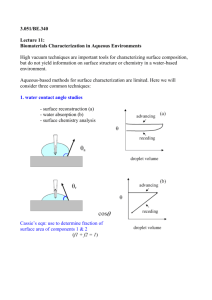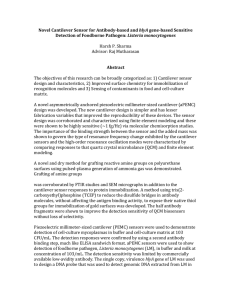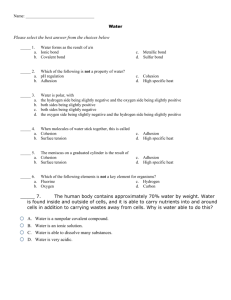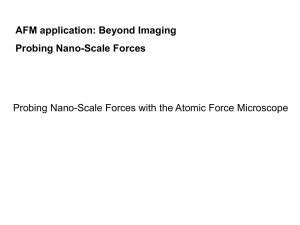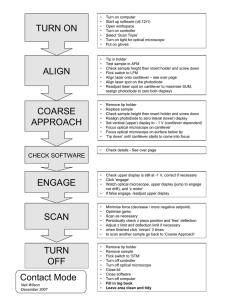FinalProjectProposal..
advertisement
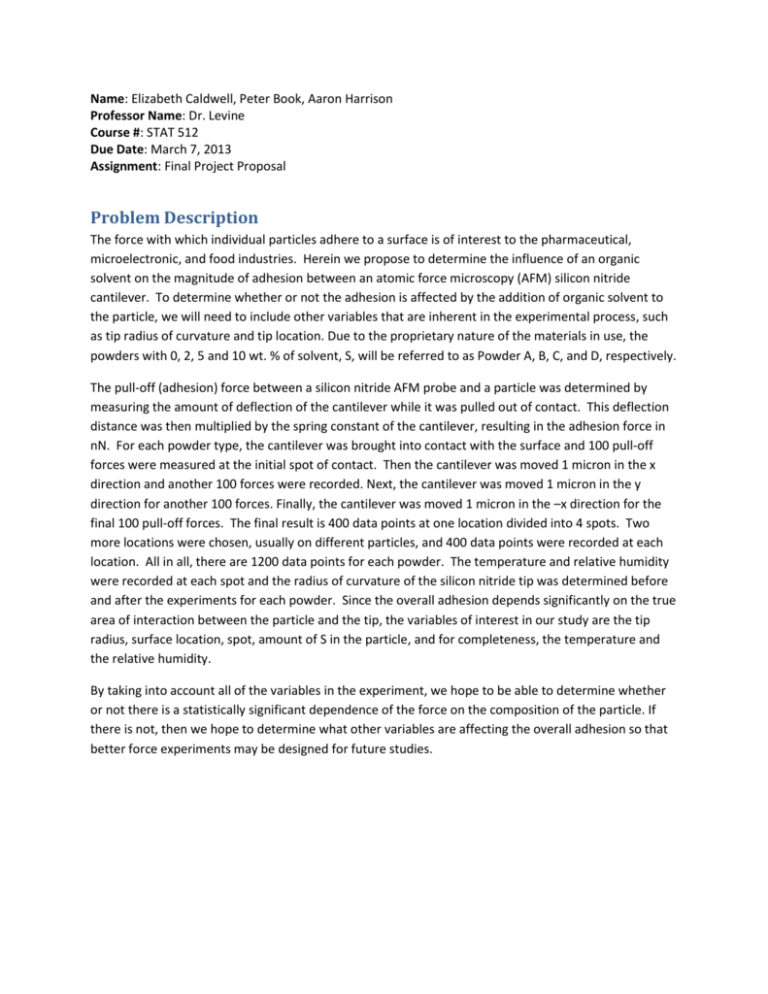
Name: Elizabeth Caldwell, Peter Book, Aaron Harrison Professor Name: Dr. Levine Course #: STAT 512 Due Date: March 7, 2013 Assignment: Final Project Proposal Problem Description The force with which individual particles adhere to a surface is of interest to the pharmaceutical, microelectronic, and food industries. Herein we propose to determine the influence of an organic solvent on the magnitude of adhesion between an atomic force microscopy (AFM) silicon nitride cantilever. To determine whether or not the adhesion is affected by the addition of organic solvent to the particle, we will need to include other variables that are inherent in the experimental process, such as tip radius of curvature and tip location. Due to the proprietary nature of the materials in use, the powders with 0, 2, 5 and 10 wt. % of solvent, S, will be referred to as Powder A, B, C, and D, respectively. The pull-off (adhesion) force between a silicon nitride AFM probe and a particle was determined by measuring the amount of deflection of the cantilever while it was pulled out of contact. This deflection distance was then multiplied by the spring constant of the cantilever, resulting in the adhesion force in nN. For each powder type, the cantilever was brought into contact with the surface and 100 pull-off forces were measured at the initial spot of contact. Then the cantilever was moved 1 micron in the x direction and another 100 forces were recorded. Next, the cantilever was moved 1 micron in the y direction for another 100 forces. Finally, the cantilever was moved 1 micron in the –x direction for the final 100 pull-off forces. The final result is 400 data points at one location divided into 4 spots. Two more locations were chosen, usually on different particles, and 400 data points were recorded at each location. All in all, there are 1200 data points for each powder. The temperature and relative humidity were recorded at each spot and the radius of curvature of the silicon nitride tip was determined before and after the experiments for each powder. Since the overall adhesion depends significantly on the true area of interaction between the particle and the tip, the variables of interest in our study are the tip radius, surface location, spot, amount of S in the particle, and for completeness, the temperature and the relative humidity. By taking into account all of the variables in the experiment, we hope to be able to determine whether or not there is a statistically significant dependence of the force on the composition of the particle. If there is not, then we hope to determine what other variables are affecting the overall adhesion so that better force experiments may be designed for future studies. Preliminary Analysis An excerpt of the data is presented in the following table: Tip ROC (nm) Location Spot Temp C Humidity Solvent wt. % Force (nN) 13 1 1 24.83 14.91 5 38.487 13 1 1 24.83 14.91 5 38.634 13 1 2 24.56 14.95 5 35.439 13 1 2 24.56 14.95 5 34.731 13 1 3 24.49 15 5 37.242 13 1 3 24.49 15 5 36.637 13 1 4 24.57 14.93 5 18.426 13 1 4 24.57 14.93 5 18.759 13 2 1 24.73 14.93 5 34.133 13 2 1 24.73 14.93 5 35.65 13 2 2 24.69 14.86 5 29.224 13 2 2 24.69 14.86 5 29.043 13 3 1 24.68 14.93 5 40.154 13 3 1 24.68 14.93 5 40.239 13 3 2 24.65 14.93 5 18.643 13 3 2 24.65 14.93 5 18.827 13 4 1 24.69 14.98 5 17.548 13 4 1 24.69 14.98 5 17.327 13 4 2 24.67 14.95 5 65.687 13 4 2 24.67 14.95 5 65.823 13 4 3 24.61 15.07 5 19.351 13 4 3 24.61 15.07 5 19.708 13 4 4 24.56 15.07 5 33.235 13 4 4 24.56 15.07 5 33.207 21 1 1 24.4 8.47 2 24.308 21 1 1 24.4 8.47 2 23.689 21 1 2 24.27 8.39 2 19.3 21 1 2 24.27 8.39 2 19.693 21 1 3 24.2 8.39 2 22.405 21 1 3 24.2 8.39 2 22.412 21 1 4 24.19 8.38 2 21.147 21 1 4 24.19 8.38 2 21.897 21 2 1 24.06 8.46 2 30.224 21 2 1 24.06 8.46 2 31.118 21 2 2 24.14 8.45 2 49.154 21 2 2 24.14 8.45 2 50.336 21 2 3 24.14 8.47 2 54.487 21 2 3 24.14 8.47 2 54.194 21 2 4 24 8.5 2 56.789 21 21 21 21 21 21 21 21 21 15 15 15 15 15 15 15 15 15 15 15 15 15 15 15 15 15 15 15 15 15 15 15 15 15 15 15 15 2 3 3 3 3 3 3 3 3 1 1 1 1 2 2 2 2 2 2 2 2 3 3 3 3 3 3 3 3 4 4 4 4 4 4 4 4 4 1 1 2 2 3 3 4 4 1 1 2 2 1 1 2 2 3 3 4 4 1 1 2 2 3 3 4 4 1 1 2 2 3 3 4 4 24 24.07 24.07 24.03 24.03 23.97 23.97 24.02 24.02 23.13 23.13 23.22 23.22 24.03 24.03 23.93 23.93 23.55 23.55 23.25 23.25 23.37 23.37 23.34 23.34 23.7 23.7 24.15 24.15 23.88 23.88 23.49 23.49 23.27 23.27 23.16 23.16 8.5 8.6 8.6 8.55 8.55 8.59 8.59 8.56 8.56 11.26 11.26 11.23 11.23 10.5 10.5 10.66 10.66 10.81 10.81 10.83 10.83 10.52 10.52 10.52 10.52 10.33 10.33 10.05 10.05 10.07 10.07 10.26 10.26 10.33 10.33 10.55 10.55 2 2 2 2 2 2 2 2 2 10 10 10 10 10 10 10 10 10 10 10 10 10 10 10 10 10 10 10 10 10 10 10 10 10 10 10 10 56.464 31.146 31.298 35.074 35.044 18.483 18.314 11.093 11.343 62.128 61.913 42.924 42.272 87.819 87.529 35.217 35.187 29.807 30.083 29.545 29.526 17.259 17.155 34.374 34.603 37.666 37.816 34.144 34.377 20.316 19.364 54.442 54.024 39.386 40.261 46.405 47.566 Preliminary Plans of Analysis For our data sets we would like to run several multiple regression tests to determine the relationship between the force and the composition of the different powders. After we create a model for our data and run an ANOVA table, we would create an F-test to conclude if any of our explanatory variables help us model the response. Aside from an F-test we can also run a multiple regression correlation test and a scatter plot matrix to further see the possible relationships. If the data is inconclusive, we either add or remove variables based on Type I SS and Type II SS which will show if any are cancelling each other out.


